When delving into the world of mountain climbing, you may feel overwhelmed by the vast array of tools and equipment available. It’s natural to wonder about the different types and appearances of these tools. Unfortunately, finding a comprehensive resource on this topic can be challenging. That’s why I’ve taken it upon myself to create one for you.
Table of Contents
Why Familiarize Yourself with Mountaineering Tools?
As you gain more knowledge and experience in mountain climbing, you’ll learn how to use each tool effectively. However, for beginners, simply acquainting yourself with the names and appearances of these tools can prove immensely helpful. This familiarity will enhance your understanding when reading books or articles on the subject.
The Importance of Safety Gear
Before we delve into the tools themselves, let’s emphasize the significance of safety equipment in mountain climbing. Protecting yourself from potential head injuries is crucial, as the risks are greater than you might imagine. Consider the following scenarios:
- Falling during a climb and colliding with a hard surface.
- Objects falling from climbers above you.
- Falling rocks and ice caused by natural elements like strong winds or tremors.
- Falling rocks and ice dislodged by climbers ahead of you.
To guard against such hazards, it is essential to wear a climbing helmet. While these helmets may be slightly uncomfortable, obstructing your view and generating heat over time, their benefits outweigh the discomfort. A head injury could result in an abrupt end to your climb and even require assistance from fellow climbers. Rescue operations are never easy, and your safety, as well as that of others, may be jeopardized. Moreover, if you find yourself in a remote location, reaching a hospital could prove challenging and time-consuming.
The Tools of the Trade
Now that we’ve underscored the importance of safety, let’s explore some of the essential tools used in mountain climbing.
Helmet
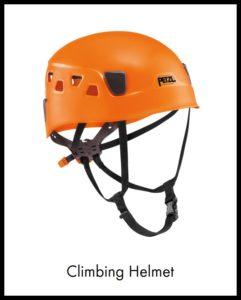
Climbing helmets serve to protect your head from potential injuries. These helmets are designed to mitigate risks that arise during a climb, as mentioned earlier.
Harness
A harness is necessary for attaching yourself to a rope during belaying and climbing. In the past, ropes were directly tied onto the climber’s body, leading to discomfort and potential injuries during falls.
Types of harnesses include:
- Seat harness
- Chest harness
- Full-body harness
Seat Harness
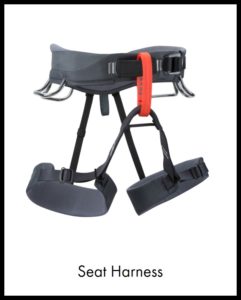
The seat harness is the most commonly used type these days. It is worn around the waist, hips, and thighs, with the climbing rope secured around the navel region. During a fall, there is a risk of flipping upside down, which the seat harness helps to prevent.
Chest Harness

In situations where flipping over is likely, a chest harness can be added. By clipping the rope through both the seat and chest harnesses, climbers can remain upright. However, a chest harness may cause rib injuries during a fall and is usually engaged only after a fall to assist with returning to an upright position.
Full Body Harness

A full-body harness combines the chest and seat harnesses into one integrated piece. The rope is tied in around the chest area. This type of harness provides better force distribution during falls and is less likely to cause injuries compared to seat or chest harnesses. However, full-body harnesses are bulkier and more expensive, making them less common in climbing. They are, however, recommended for children, as their hips are not fully developed, and they have a higher center of gravity, making them more prone to flipping upside down when using a seat harness.
Ropes

Ropes are crucial tools in mountain climbing. It is important to understand the different types available:
- Dynamic ropes
- Single ropes
- Twin ropes
- Double/half ropes
- Static ropes
Dynamic Ropes
All ropes used for climbing must be dynamic ropes, which can stretch and elongate when subjected to load. This property allows them to absorb the impact during a climber’s fall. There are three types of dynamic ropes: single ropes, twin ropes, and double/half ropes.
Single ropes can be used individually, while twin and double/half ropes must be used in pairs. The diameter of dynamic ropes typically ranges from 7mm to 11mm, with single ropes generally being thicker than twin and double/half ropes. The lengths of dynamic ropes can vary from 30 meters to 80 meters (100 feet to 260 feet). As a general rule, the length of rope needed should be at least twice the length of the climbing route. For instance, if you are ascending a 100-foot tall wall, you would require 200 feet of rope.
Static Ropes
In contrast, static ropes lack the ability to stretch and elongate. They are primarily used for transporting equipment or engaging in rescue operations, where stretchiness is not desirable as it would affect the stability of the load.
Carabiners

Carabiners are the workhorses of climbing gear, serving a multitude of purposes such as belaying, rappelling, and securing ropes to protection points and safety anchors. They come in various shapes: oval, D-shaped, offset D-shaped, and pear-shaped. D-shaped and offset D-shaped carabiners are stronger than oval and pear-shaped ones.
The gate of a carabiner can also have different variations, including straight, bent, or wire gates. Bent gates make clipping ropes into and out of carabiners easier, while wire gates provide a lighter and stronger alternative to traditional gates. Certain carabiners with straight or bent gates may also feature a locking mechanism to prevent accidental opening during climbs. This feature is crucial, as it ensures that a rope does not come loose from an anchor point, which could be catastrophic.
Runner/Slings
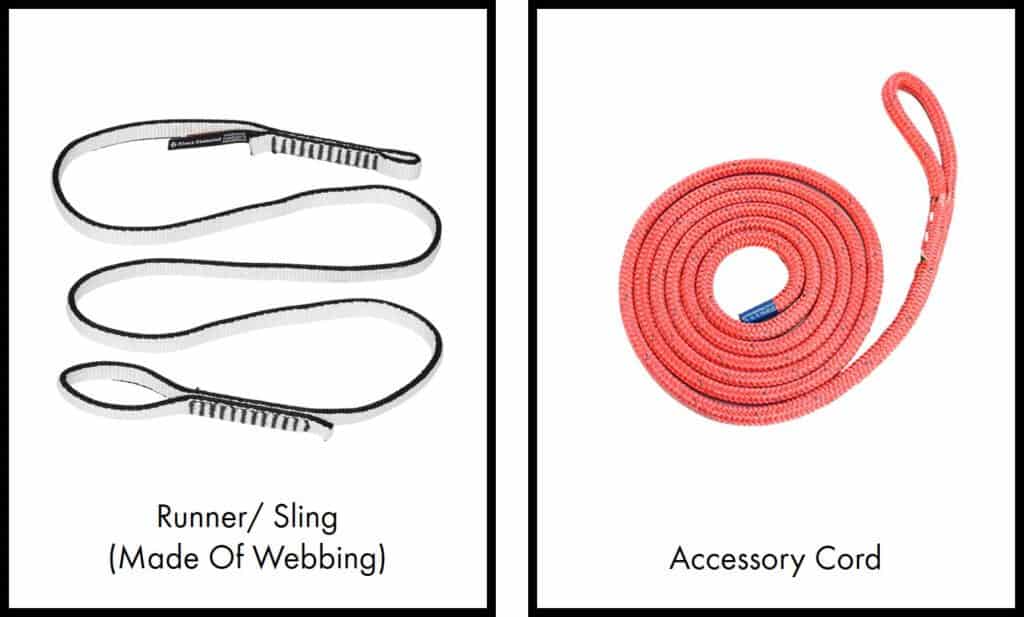
When first reading about webbing, cords, runners, slings, and quickdraws, it’s easy to become confused. These terms are often lumped together without clear explanations of their differences. Allow me to clarify:
Runners and slings are essentially the same thing and are used for setting up anchors and belay points. They can be made from materials such as webbing (tubular webbing) or cords (accessory cords). Webbings are flat strips or tubes of fabric, which can be sewn or tied to form runners or slings. Cords, on the other hand, are a type of static rope, and you can create a runner or sling by tying a cord into a loop.
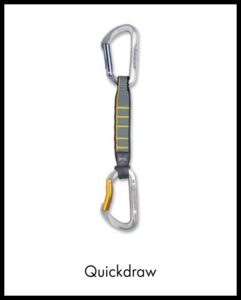
A quickdraw consists of two carabiners fastened to both ends of a sewn webbing.
Belay Device
A belay device is used to apply friction to the climbing rope, functioning as a brake. There are two main types:
- Aperture devices
- Slot plate
- Tubular
- Figure 8
- Self-braking devices
- Aperture-style
- Spring-loaded
Aperture Belay Devices
Aperture belay devices feature an opening through which a loop of rope passes. This loop is secured with a locking carabiner, which is then attached to the harness. Aperture devices come in various shapes and forms.
Slot Plate

The slot plate is a flat plate-shaped belay device.
Tubular

The tubular belay device is shaped like a tube or cuboid. The ATC (Air Traffic Controller) is a common example of a tubular belay device.
Figure 8
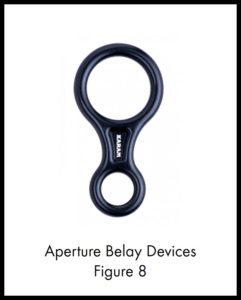
The figure 8 belay device is named for its shape. While primarily used for rappelling, some figure 8 devices are suitable for belaying as well.
Self-braking Belay Devices
Self-braking belay devices, also known as self-locking, autolocking, or mechanical-assisting belay devices, contain an internal mechanism that automatically locks the ropes during a fall. However, it is still essential to keep a hand on the rope as you use these devices. It’s important to note that the effectiveness of these mechanisms may vary with different rope diameters, so referencing the manufacturer’s specifications is crucial.
There are two types of self-braking belay devices:
Aperture-style Self-braking Belay
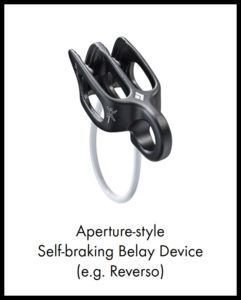
Aperture-style self-braking belay devices resemble aperture belay devices, but with two additional loops for self-braking. They are not suitable for rappelling or lowering climbers, as they tend to lock up under load.
A popular example of this device is the Reverso.
Spring-loaded Belay Devices
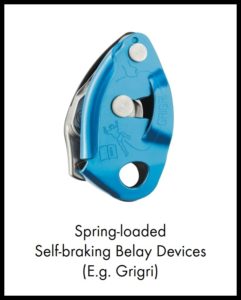
Spring-loaded belay devices possess an internal cam mechanism that locks onto the rope during a fall. They also have a mechanism to release this lock for rappelling or lowering climbers. The Grigri is a well-known example of a spring-loaded belay device.
Rock Climbing Anchors
When rock climbing, anchors are vital for connecting climbers and belayers to the rock surface, ensuring safety during falls. There are two main categories of rock climbing anchors: fixed anchors and removable anchors.
Fixed Rock Climbing Anchors
Fixed anchors are typically found on well-established climbing routes or at climbing gyms. They come in two types: bolts and pitons.
Bolt
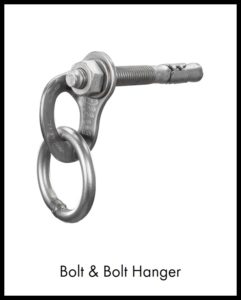
Bolts are commonly used in contemporary climbing. They resemble large tubular screws and range in diameter from 10mm to 14mm. Most bolts feature a bolt hanger to facilitate the attachment of carabiners. However, it’s worth noting that outdoor climbing areas may not always have bolt hangers, so carrying additional ones is prudent.
Piton

Pitons are wedge-shaped metal pieces inserted into cracks in the rock, allowing climbers to secure themselves directly onto them. While less common nowadays due to their propensity to damage rock structures and weathering susceptibility, pitons provide an alternative to bolts.
Removable Rock Climbing Anchors (Chocks)
Removable anchors, also known as chocks, are inserted into cracks or openings within rock formations. They consist of passive or active anchors.
Passive Rock Climbing Anchors
Passive anchors are static metal pieces attached to a cable. Their shapes and sizes vary to accommodate different rock conditions. When selecting a passive anchor, opt for one that maximizes contact with the rock, as this provides the strongest hold. Common types of passive anchors include:
- Nuts: Trapezoid-shaped metal pieces, also referred to as stoppers or wedges.
- Hexes: Hexagonal-shaped anchors.
- Tri-Cams: Anchors with rounded sides and sharp points.
- Tube Chocks: Tubular-shaped anchors.
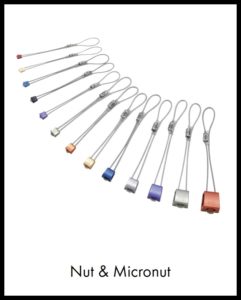
Active Rock Climbing Anchors
Active anchors feature a moving part that can be contracted with a lever, enabling climbers to secure them within rock cracks before releasing the lever. The camming device, or cam, is a popular example of an active anchor. It consists of three to four semi-circular metal pieces that expand and contract by pressing on the lever.

Ice Axe
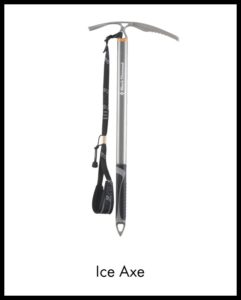
An ice axe is a versatile tool when navigating snowy or icy terrains. Its design and length depend on your height and specific use. The length of an ice axe typically ranges from 40 cm to 90 cm (16 in to 35 in), with taller climbers requiring longer axes. Steeper terrains call for shorter axes to ensure proper control and grip.
Ice axes serve various purposes, including acting as hiking aids for stability, cutting steps in hard snow or ice, anchoring during steep ascents, arresting falls, and creating anchors for belaying.
Ice Tool
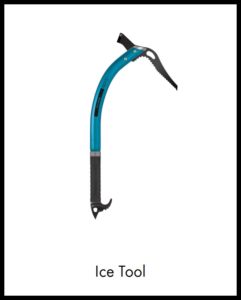
An ice tool is a specialized version of an ice axe used specifically for technical ice climbing. These tools are typically shorter than 60 cm (24 in), with longer ice axes proving less effective in technical ascents. Ice tools feature a hammerhead at the top, allowing climbers to drive anchors into ice for added stability.
Crampons

Crampons are metal spikes strapped onto boots to enhance traction on hard snow and ice. They come in different levels of stiffness and rigidity, along with various attachment systems.
Types of crampons include:
- C1 crampons: The most flexible type, hinged to offer flexibility. They usually feature straps at the front and back for attachment.
- C2 crampons: A hybrid between C1 and C3 crampons, providing a balance between stiffness and flexibility. They usually incorporate front clips and rear straps.
- C3 crampons: The stiffest and heaviest type, featuring front and rear clips for attachment. These crampons require corresponding boots with sufficient rigidity.
Snowshoes
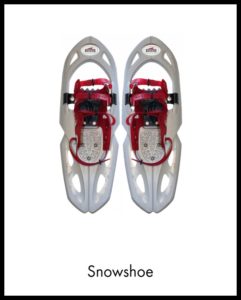
Snowshoes are designed for walking over soft snow, equipped with metal spikes to enhance traction on hard snow surfaces. Snowshoes are not rated for specific requirements and can be worn with any type of footwear.
Snow or Ice Climbing Anchors
When climbing on snow or ice, anchors are essential for rappelling and belaying. However, placing anchors in snow and ice is more challenging than in rock, as their strength heavily relies on snow and ice conditions. Here are the types of ice and snow anchors to consider:
Ice Anchors
Ice screws are hollow-core ice anchors. As they are screwed into the ice, displaced ice exits through the core. Ice screws can be made of steel, aluminum, or titanium, with lengths ranging from 10 cm to 22 cm (4 in to 9 in). Longer ice screws can withstand greater weight.
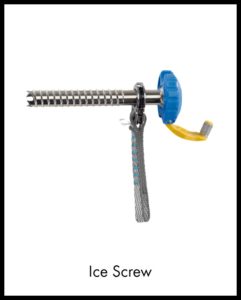
Snow Anchors
Snow anchors are crucial for reliable support in snowy conditions. Two common types of snow anchors are:
- Picket: An aluminum stake driven into the snow or ice to serve as an anchor.
- Snow Fluke: An aluminum plate attached to a metal cable. Snow flukes are effective in heavy, moist snow conditions but may not perform well in less ideal conditions.
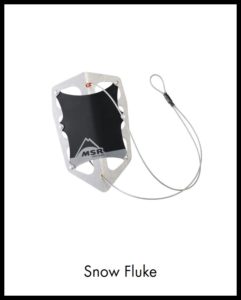
Explore the World of Mountain Climbing
Now that you have a comprehensive understanding of the tools and equipment used in mountain climbing, you can feel more confident embarking on your climbing journey. Remember, safety should always be your top priority. Proper knowledge, along with the right tools, will ensure an enjoyable and secure climbing experience.
This article is part of the “Introduction to Mountain Climbing Mini-series” by 5 WS. Stay tuned for the subsequent articles in this series, each delving further into the world of mountain climbing:
- Part 1: How to Start Mountain Climbing Today
- Part 2: When Do You Need Mountain Climbing Courses
- Part 3: Mountaineering Tools and Equipment 101
- Part 4: What to Bring for Mountain Climbing
- Part 5: What Are the Dangers of Mountain Climbing
Feel free to save this article as a handy reference to Pinterest!

